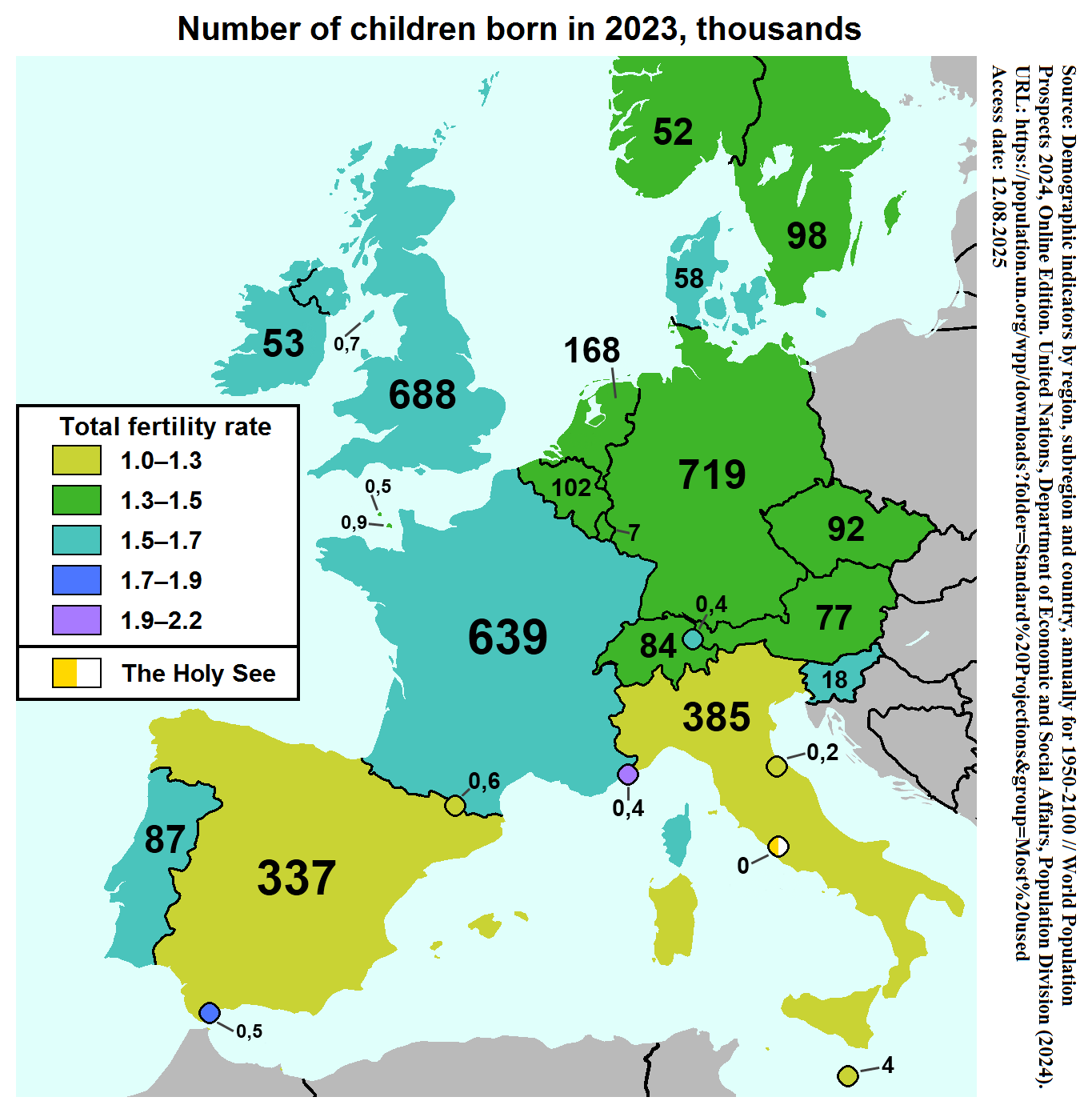Total Fertility Rate and Children Born Map Western Europe 2023


David Chen
Data Visualization Specialist
David Chen is an expert in transforming complex geographic datasets into compelling visual narratives. He combines his background in computer science ...
Geographic Analysis
What This Map Shows
The map titled "Total Fertility Rate and Number of Children Born in Western Europe, 2023" visually represents the fertility trends across various Western European countries. By illustrating both the total fertility rate (TFR) and the actual number of children born, the map provides a comprehensive snapshot of demographic patterns that influence the region's population dynamics. The TFR is a crucial measure in understanding reproductive behavior, indicating the average number of children a woman would have in her lifetime based on current birth rates. This data allows us to draw essential conclusions about family planning, societal values, and future population growth in Western Europe.
Deep Dive into Total Fertility Rates
Total fertility rate is not just a number; it encapsulates the social and economic conditions of a region. In Western Europe, the TFR has seen a notable decline over the past few decades, driven by various factors such as increased access to education, changing gender roles, and economic considerations. For instance, countries like Germany and Italy have TFRs below the replacement level of 2.1, which raises concerns about an aging population and potential labor shortages in the future.
Interestingly, what's fascinating is that this decline does not uniformly apply to all countries in the region. Nordic countries like Sweden and Denmark showcase relatively higher fertility rates, often attributed to robust parental support systems and progressive family policies. In Sweden, for instance, government initiatives provide generous parental leave and subsidized childcare, making it more feasible for families to have children.
Moreover, cultural factors also play a significant role in shaping fertility rates. In countries like France, where family-friendly policies are well-established, couples tend to have more children compared to their counterparts in Eastern Europe or the UK, where economic pressures and housing costs may deter larger families. In 2023, France's total fertility rate hovers around 1.83, displaying a resilience that many other Western nations aspire to achieve.
Statistics reveal that while some countries are struggling with low birth rates, others are experiencing a slight resurgence in fertility, thanks in part to immigration and changing attitudes towards family structures. The TFR in Ireland, for example, has rebounded to around 1.8, reflecting a youthful population and a cultural inclination towards larger families.
Regional Analysis
When we break down the map by individual countries, the differences in fertility rates become starkly apparent. Countries like Spain and Italy, with TFRs of approximately 1.4 and 1.3 respectively, face significant demographic challenges. These nations are witnessing the effects of prolonged economic uncertainty, leading to delayed family formation and childbearing. Interestingly, Spain has also seen a rise in single-parent households, which indicates shifting societal norms around family life.
In contrast, the Benelux countries, consisting of Belgium, the Netherlands, and Luxembourg, portray a more balanced picture. Their TFRs are closer to the European average, hovering around 1.7 to 1.8, suggesting a stable demographic outlook. This stability can be attributed to effective family support policies and a strong emphasis on work-life balance.
The UK presents a mixed picture as well. With a TFR of approximately 1.6, it reflects a trend towards later childbearing, particularly in urban areas where housing and living costs are high. However, regions in the North, such as the North East, display higher birth rates compared to the South, illustrating how economic disparities influence family planning decisions.
Significance and Impact
Why does understanding the total fertility rate matter, particularly in Western Europe? The implications are profound, affecting everything from economic growth to healthcare systems and social services. A declining fertility rate can lead to an aging population, putting pressure on pension systems and increasing healthcare costs. Countries like Italy and Germany are already grappling with these challenges, which could impact their economies for decades.
Furthermore, as societies evolve, the demand for family-friendly policies becomes increasingly essential. Governments need to adapt by creating environments that support families through parental leave, affordable childcare, and housing solutions. The 2023 map serves as a crucial reminder that demographic trends are not just statistics; they reflect the lives and choices of individuals across the continent. Moving forward, understanding these patterns will be vital for policymakers, businesses, and communities alike as they navigate the complexities of a changing population landscape in Western Europe.
Ultimately, as we look to the future, the trends shown in this map will be instrumental in shaping not just demographics, but the very fabric of society in Western Europe.
Visualization Details
- Published
- October 8, 2025
- Views
- 36
Comments
Loading comments...